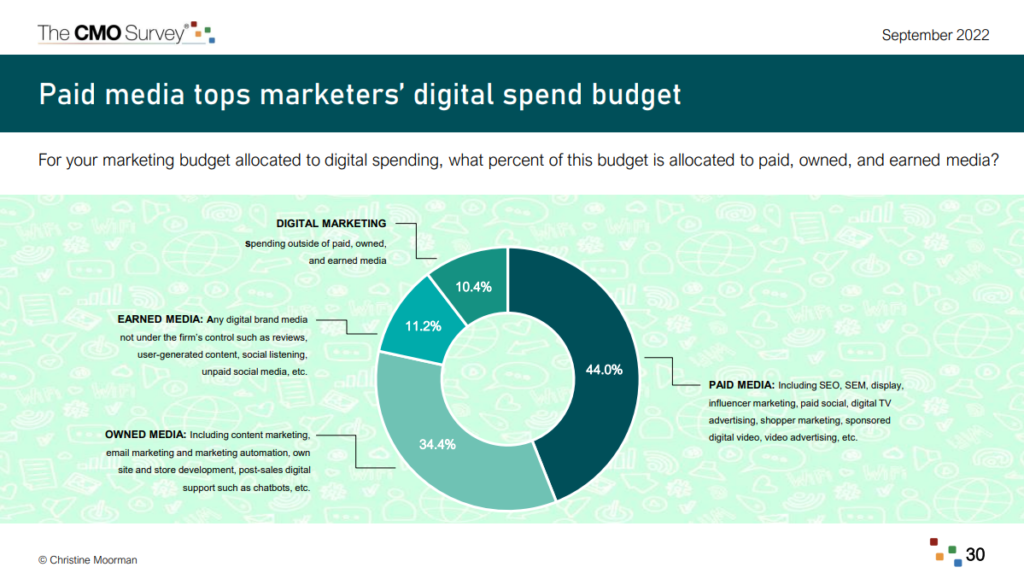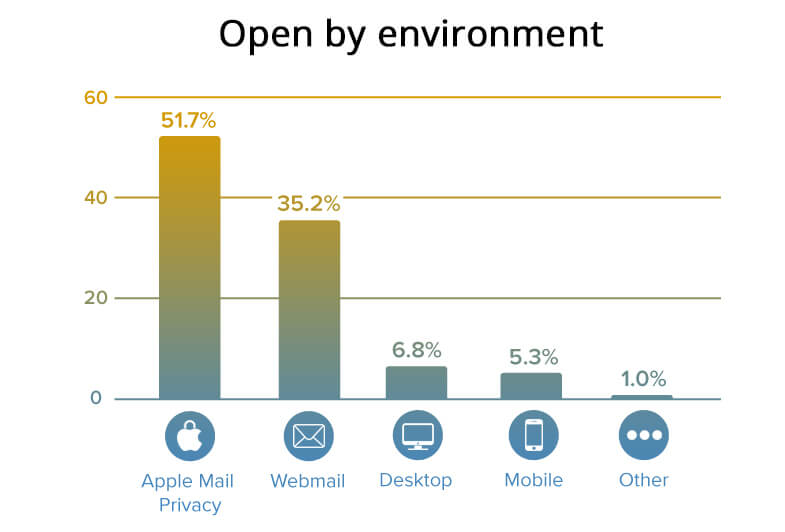Updated March 4, 2025
Reading Time: 7 minutes
We’re nearing the last quarter of the year – that means preparing for your 2023 marketing game plan. Digital marketing topics gaining headlines include video content overtaking traditional web content, rising privacy concerns, and sales funnel marketing morphing. We’ve assembled the digital marketing trends for 2023 from a variety of trusted research sources and first-hand experience in working with B2C and B2B clients.
Included in this article:
Marketing Spending at its Highest in the Last Decade
Marketing budgets are resetting to pre-pandemic levels, according to The CMO Survey. Compared to last year’s percentage, marketing executives indicate their budgets have grown 11.8%. Looking back over a decade, annual marketing-related spending has averaged over 10% and is predicted to keep increasing.
So how are marketers using their budgets? 57.9% of marketing budgets are spent on digital marketing activities, with the lion share (44%) allocated to paid media, according to the most recent CMO Survey. In general, marketers are investing in video marketing, brand building, customer relationships, and improving online presence through influencers, SEO, and content. Spending on traditional advertising is expected to continue its dip in 2023, falling into pre-Covid territory.
Let’s look deeper at how marketing dollars will be allocated in 2023 and beyond.

8 Digital Marketing Trends
These trends aren’t in any particular order. While you may not currently utilize some of these marketing strategies, they are worthy of your attention and consideration.
1. Short-form Video Marketing
Tiktok has once overtaken Google as the most popular domain in 2021. Until now, they’re still in the top 20s with 1.5 billion visits this July 2022. Instagram has reels. YouTube has shorts. To put it simply, short-form videos are the new way of video consumption and marketers are quick to capitalize on this emerging behavior. In fact, the short-form video proves to have the best ROI when compared to other media formats. Youtube is still the most popular platform for video content, and 30% of marketers made plans to try their hand at it for the first time. Video consumption is still at its peak according to Statistica’s findings where US residents spend 1140 minutes a week on average watching videos on mobile alone.
So what are marketers’ main goals for short-form video content? Driving brand awareness, product education, and driving customer engagement and/or leads.
2. Micro-Influencer Marketing
What’s working for B2B and B2C brands? Well, LinkedIn proves to be effective for B2B but not for B2C brands. B2B brands are seeing ROI on Tiktok, with 58% of B2B marketers planning to increase their investment in this channel.
Facebook ads come out as the biggest ROI generator among other social media platforms for both B2B and B2C organizations. Meanwhile, 62% of marketing budgets this year were used on Tiktok, Instagram, and Youtube because of the rise in video consumption.
Influencers on these platforms are partnering with B2B and B2C brands to reach new customers, foster trust, and raise brand awareness. And the research backs this decision. Hubspot Research shows the response of B2B clients to be positive, finding that co-branded or sponsored 3rd-party content is more trustworthy than receiving content straight from a company.
Influencers typically fall into two categories: 1) Nano or Micro-influencers with 10K-100K followers and 2) Mega or Macro-influencers with 100K-1+M followers. Due to their niche following, micro-influencers have 60% higher engagement, more affordable rates, and are better at promoting products and services specific to their followers’ interests.
3. Stronger Privacy Strategies
Third-party cookies will be out by 2023. It’s a wake-up call for any company or marketing team that has not prioritized managing their customers’ privacy concerns. Marketers realize they have to create stronger privacy strategies while building customer trust. Brands are looking for ways to prioritize acquiring zero and first-party data through email preference centers, segmentation, and email interaction.
With Google Analytics being banned in Italy this year along with several other countries, we can expect more and more companies to take data and privacy seriously. Complying with the General Data Protection Regulation (GDPR) and California Consumer Privacy Act (CCPA) plus the ePrivacy Directive or ePR will be important legal requirements for business websites.

4. Advocating Diversity, Equity, and Inclusion (DEI)
Expectations are higher than ever amid growing concerns for sustainability, workplace ethics, inclusivity, and responsibility. Deloitte reports the most impactful results from DEI initiatives including increased employee acquisition/retention, improved brand reputation, and improved stakeholder relationships.
Social responsibility has become a marketing tactic for those organizations that understand the impact. It’s a longer-term strategy as buyers are more likely to be loyal to companies that share their values and demonstrate those values thru business initiatives and even philanthropic endeavors.
Another aspect of inclusivity is to contribute to accessible web space for all. Web accessibility considers the needs of those with disabilities, using technologies designed and developed to aid in better perception, navigation, and understanding of web content. You’ll see more and more websites are investing in this web accessibility trend, evidenced by high-contrast text and background color, breadcrumb navigation, font size, and similar techniques.
5. Quality Content & Cadence
Hubspot reports that 83% of marketers find that creating higher-quality content less often is more effective than posting lower-quality content more frequently. Posting 2-3 times a week on Instagram works well for B2B brands in particular. SEO, content marketing, and building a robust online presence are still effective. 77% of B2C marketers report using these tactics compared to 66% of B2B marketers.
These content-related marketing trends are on the upswing: interactive content, authentic “behind the scenes” content, as well as content reflecting a brand’s values. Creating helpful, well-written content can turn one-time visitors into fans that share your brand with others. We expound more about content with our blog on Content Marketing Trends for 2023. To further leverage published content, consider automating your sales outreach by building a digital marketing funnel.
6. Need for Automation, Machine Learning, and Rev Ops
Artificial intelligence (AI) and machine learning (ML) are not new trends we expect to rise significantly as we approach 2023 and beyond. In 2022, 43% of marketers agree that automation will help their organizations grow. The need for automation arises as companies want to save time and money for repetitive tasks or routine daily tasks. For example, chatbots are becoming more common. Nearly 40% of users prefer an instant, automatic response. Marketers also putting more value on AI-powered segmentation with integrations used by Zyratalk, MailChimp, Google Ads, and even Gmail.
With all the talk about AIs and bots, Google released an algorithm update called “helpful content”.
7. New Ways to Search
74% of online shoppers consider text-based search to be ineffective while 29.5% of users are now using image search tools on their phones. Image of visual search is not new, yet it’s becoming an increasingly common way to search. Google and other search engines use three processes to do this: text image search, a reverse image search using schema, and snap-and-search. It will be interesting to see how image SEO will evolve as current techniques involve schema markup and submitting images to sitemaps.
“Hey Siri, Alexa, Google” – it’s obvious that voice search is another trend on the rise. 71% of searchers would choose to do a voice search query over typing the text. Right now, millennials are the most prominent users. Yet older age groups are joining in by using mobile assistants, interactive speakers, and voice-activated search tools on their devices. While this trend may not seem to be immediately helpful for B2B companies who cater to target the C-Suite who make considered purchasing decisions, voice search will eventually overtake current search behaviors.
8. Marketing Jobs & Hybrid Work Environment
You’ve probably seen the headlines “the Great Resignation,” “the Great Vacation” or the “Quiet Quitting.” Yes, the business landscape is quickly evolving. Baby Boomers are retiring and Gen Z is entering the workforce. The pandemic has changed the way many of us work, leaving many feeling burn-out, reluctant to resume long commutes, or wishing for more work-life balance. Expect hybrid work, work flexibility, and empowering employees through specialized training and mentoring to continue into 2023.

Job growth, especially in marketing departments is expected in 2023. The CMO Survey showed a 12.2% increase in the last year, and leaders predict a 10.5% increase over the next 12 months. In general, marketers are investing in hiring and training new employees with skills and experience with the above-mentioned marketing trends.
Digital Marketing Predictions 2023
At Spectrum, we work with a wide variety of clients and have the opportunity to see what’s happening in B2C, B2B, and niche markets. Here are a few of our 2023 digital marketing predictions:
- Brands will continue expanding their digital marketing footprint. We’re seeing more complex strategies spanning multiple channels. This expansion also means an increased appetite for testing new channels and messaging.
- As marketing budgets grow, the greater the need for data for monitoring and decision-making. We’re seeing a willingness to embrace more technically-involved tracking solutions requiring more sophisticated integrations and data dashboards.
- As chatbots are becoming mainstream, brands that have been resistant to automated messaging are now exploring this opportunity. Chatbots can help with sales conversations but also boost customer satisfaction.
- The pandemic accelerated the digital transformation for those who lagged behind their competitors. By embracing these changes and implementing accurate tracking, leaders are now seeing the data reflecting the interconnectedness of all digital channels to drive traffic and conversions. For complex or lengthy sales processes, it is not uncommon for multiple touches across all types of channels (e.g., ads, Google Business Profile, social, organic).
- It’s easy to waste money on online ads. We’ve onboarded new clients because they realize that specialized skills are needed to manage paid advertising channels effectively. Additionally, brands are actively looking for alternatives and opportunities — even with platforms with smaller market share (e.g., Microsoft) to test and expand their reach.
Want to read more? Strategize your content marketing strategy with these content marketing trends for 2023.

 Spectrum Microsoft Partner Status 2022
Spectrum Microsoft Partner Status 2022
Great read regarding the various types of upcoming digital marketing trends and their benefits for continued business success. Thanks for this.
Ya, It’s such a nice post. It will help many digital marketing companies to boost their market presence in the upcoming time. Thanks for publishing it.
thanks for sharing , great content
Great blog post Your discussion on marketing trends is very enlightening. Our agency provides expert SEO, SMO, SMM, and IT services, including Lead Generation. We aim to deliver exceptional outcomes for our clients.
Thank you! We’re glad you found it helpful.